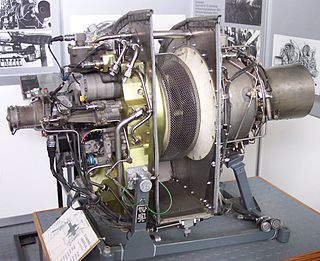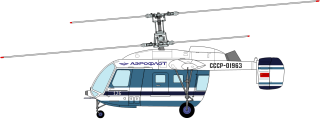
The Kamov Ka-50 "Black Shark", NATO reporting name Hokum A, is a Soviet/Russian single-seat attack helicopter with the distinctive coaxial rotor system of the Kamov design bureau. It was designed in the 1980s and adopted for service in the Russian army in 1995. The Ka-50 is manufactured by the Progress company in Arsenyev. It is used as a heavily armed scout helicopter, and is notable for having a rescue ejection system, rare for helicopters.

Hindustan Aeronautics Limited (HAL) is an Indian public sector aerospace and defence company, headquartered in Bangalore. Established on 23 December 1940, HAL is one of the oldest and largest aerospace and defence manufacturers in the world. HAL began aircraft manufacturing as early as 1942 with licensed production of Harlow PC-5, Curtiss P-36 Hawk and Vultee A-31 Vengeance for the Indian Air Force. HAL currently has 11 dedicated Research and development (R&D) centres and 21 manufacturing divisions under 4 production units spread across India. HAL is managed by a board of directors appointed by the President of India through the Ministry of Defence, Government of India. HAL is currently involved in designing and manufacturing of fighter jets, helicopters, jet engine and marine gas turbine engine, avionics, software development, spares supply, overhauling and upgrading of Indian military aircraft.

The EurocopterAS565 Panther is the military version of the Eurocopter AS365 Dauphin medium-weight multi-purpose twin-engine helicopter. The Panther is used for a wide range of military roles, including combat assault, fire support, anti-submarine warfare, anti-surface warfare, search and rescue, and medical evacuation.

The Kamov Ka-27 is a military helicopter developed for the Soviet Navy, and currently in service in various countries including Russia, Ukraine, Vietnam, China, South Korea, and India. Variants include the Ka-29 assault transport, the Ka-28 downgraded export version, and the Ka-32 for civilian use.

The Mil Mi-38 is a transport helicopter designed by Mil Moscow Helicopter Plant and being developed by Kazan Helicopters. Originally intended as a replacement for the Mil Mi-8 and the Mi-17, it is being marketed in both military and civil versions. It flew for the first time on 22 December 2003 and was certified on 30 December 2015.

The Mil Mi-28 is a Soviet all-weather, day-night, military tandem, two-seat anti-armor attack helicopter. It is an attack helicopter with no intended secondary transport capability, better optimized than the Mil Mi-24 gunship for the role. It carries a single gun in an undernose barbette, plus external loads carried on pylons beneath stub wings.

The Kamov Ka-26 is a Soviet light utility helicopter with co-axial rotors.

The Kamov Ka-60 Kasatka (Russian: "Касатка", is a Russian medium twin-turbine military transport helicopter under development by Kamov. It performed its first flight on 24 December 1998.

The Eurocopter EC135, now Airbus Helicopters H135, is a twin-engine civil light utility helicopter produced by Airbus Helicopters, formerly known as Eurocopter. It is capable of flight under instrument flight rules (IFR) and is outfitted with a digital automatic flight control system (AFCS). First flying in February 1994, it entered service in 1996. 1,400 have been delivered up to September 2020, to 300 operators in 60 countries, accumulating over 5 million flight hours. It is mainly used for air medical transport (medevac), corporate transport, law enforcement, offshore wind support, and military flight training. Half of them are in Europe and a quarter in North America. The H135M, certified under the name Eurocopter EC635, is a military variant, so the overall design is known as the Airbus Helicopters H135 and the military version, as the Airbus Helicopters H135M. The EC135/H135 is a development of the older Messerschmitt-Bölkow-Blohm (MBB) Bo 105.

The Kazan Ansat is a Russian light, multipurpose helicopter manufactured by Kazan Helicopters.

OPK Oboronprom was a Russian aerospace holding company. The company was involved in helicopter production, engine production, air-defence systems, complex radio-electronic systems and leasing. Russian Helicopters, Oboronprom’s helicopter manufacturing group is the leading Russian designer and manufacturer of rotary-wing aircraft equipment.

The EurocopterAS355 Écureuil 2 is a twin-engine light utility helicopter developed and originally manufactured by Aérospatiale in France.

The Turbomeca Arrius is one of a family of turboshaft engines for helicopter use, first produced in 1981. As of 2012, some 2,700 units had been sold. Power ranges between 357 kW and 530 kW for different versions. Following Turbomeca tradition, the Arrius was named after a Pyrenean peak, located in the Ossau Valley near Pau.

The Eurocopter EC635 is a multi-purpose light helicopter developed by Eurocopter as a military version of the Eurocopter EC135. It is a twin-engined aircraft and can carry up to 8 people, including the pilot, and a range of military equipment or armaments. The helicopter is marketed for troop transport, medical evacuation, cargo transport, reconnaissance and surveillance and armed combat support missions.

The Kamov Ka-126 is a Soviet light utility helicopter with co-axial rotors. Evolved from Ka-26 with engine pods removed from stub wings, fitted with one TVO-100 turboshaft engine positioned on top of fuselage, modified rotor blades, new fuel system.

The HAL Light Utility Helicopter (LUH) along with its derivative Light Observation Helicopter (LOH) was designed and developed by Rotary Wing Research and Design Center (RWR&DC) one of the R&D sections of Hindustan Aeronautics Limited (HAL) for civilian and military applications. These are intended to replace license-built versions of Aérospatiale SA 315B Lama (designated Cheetah) and Aérospatiale Alouette III (designated Chetak) in service with Indian Army and Indian Air Force.

The Klimov TV3-117 is a Soviet gas turbine aero engine. It is used in most medium lift, utility, and attack helicopters designed by the Mil and Kamov design bureaus. The TV3-117 turboshaft engine was developed in 1974. Later the Klimov TV3-117 was installed on 95% of all helicopters designed by Mil and Kamov Engineering Centre. The engine has been produced in many variants.
JSC Russian Helicopters is a helicopter design and manufacturing company headquartered in Moscow, Russia. The company designs and manufactures civilian and military helicopters. The company's principal shareholder is Rostec. It is the world's 24th-largest defence contractor measured by 2012 defence revenues, and the second-largest based in Russia.

The VRT 500 is a project of a light helicopter with a coaxial rotor developed by VR-Technologies (VRT), a subsidiary of Russian Helicopters.

The Syzran Higher Military Aviation School is a military academy of the Russian Aerospace Forces, responsible for training airmen of the Russian Armed Forces. It is a branch of the Zhukovsky – Gagarin Air Force Academy.






















